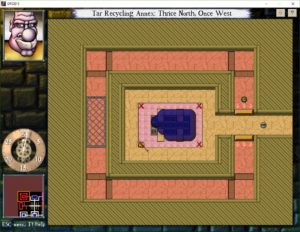The Second Sky: Temporal Aumtlich
In the classic Sega ninja arcade game Shinobi, the player can use a special “ninja magic” attack once per level, clearing the screen of enemies. Depending on the level, you get either a lightning storm, a whirlwind, or a “doppelganger” attack, in which duplicates of the player burst out from him and bounce around with a thundering noise. Despite being surrounded by other ninjas, the player character has exclusive access to these magics — until the final boss. He has all your spells, and uses them against you. Except, because the game is designed to be winnable, his versions are weaker than yours. His whirlwind attack is dodgeable. His lightning is localized. His doppelgangers emerge one at a time, and can be fought and overcome like any other ninja.
This was brought to mind by events in the swirling temporal maelstrom that Beethro finds himself in after jumping through a few time portals. It’s a place of chaos: precipices over a foggy void, lighting that’s dim and erratic enough that I can’t tell what color a gate is until there’s a flash of lightning, segments of floor that appear and disappear. The ever-useful clock in the UI doesn’t work properly here, sometimes moving backwards. This is the home of the Temporal Aumtlich.
In a sense, there’s only one Temporal Aumtlich, but you have to kill him over and over. That’s because he’s capable of spawning time-clones of himself — just like Beethro does when he steps on a temporal split token. This comes on the heels of several levels all about time-cloning puzzles, so this is one of those Shinobi moments, where you encounter an enemy with powers similar to yours, and it somehow doesn’t seem fair. Time-cloning is a very powerful tool, even if the puzzles are set up to make it difficult to apply correctly, and now that tool is being used against you. And unlike the Master Ninja’s knock-offs, the Temporal Aumtlich’s version is better than yours. Unlike Beethro, killing one branch doesn’t kill the others. Also, he doesn’t need a time split token; his power is intrinsic, and he can apply it anywhere, as many times as he likes, turning himself into an army.
In practice, though, his splits are predictable, linked to his movement, which is as controllable as that of any other monster. What he does is: Whenever he has a choice of two equally-direct paths towards you, he takes both. It reminds me a little of a non-deterministic Turing machine, an abstraction used in theoretical computer science that’s sometimes described as a computer that’s capable of splitting into two identical computers so it can explore two execution paths simultaneously. But the branches of a non-deterministic Turing machines aren’t capable of getting in each others’ way like the Temporal Aumtlich does.
So this is a tense set of puzzles, based around a problem that can keep getting worse, but it’s nonetheless something that you can learn to manage. Some of the more difficult puzzles actually require you to deliberately spawn new Temporal Aumtlich instances under your control.
 Comments(0)
Comments(0)
